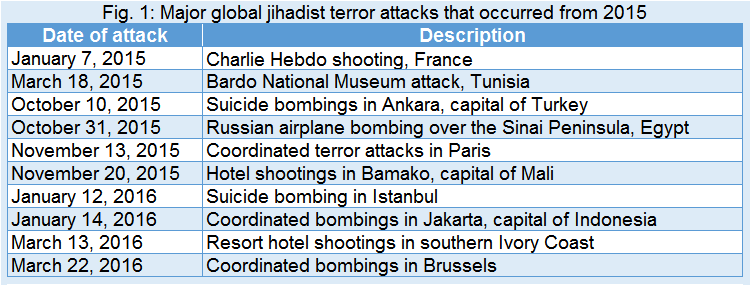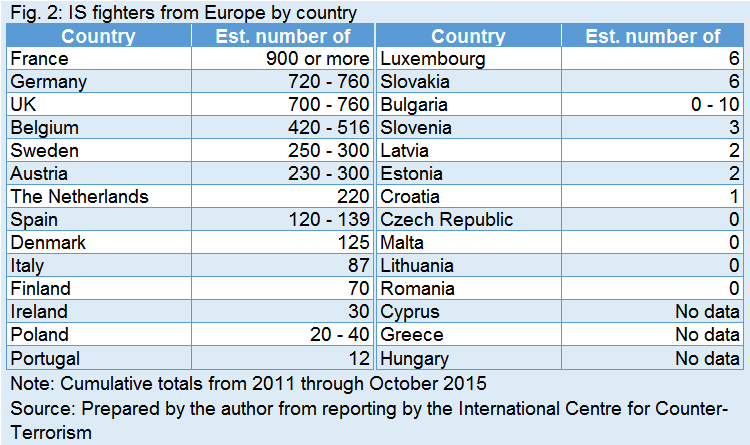Mitsui & Co. Global Strategic Studies Institute
The State of Global Jihad Terror
May 2, 2016
Keiichi Shirato
Middle East & Africa Dept. Mitsui Global Strategic Studies Institute
Main Contents

Acts of terrorism based on the ideology of a global jihad (holy war on a world scale) aimed at establishing an Islamic state are being committed successively. In addition to Turkey, Tunisia, and other Middle Eastern and Northern African countries that have relatively stable public security, France, Belgium, and other central European nations are also being visited by terrorism (Fig. 1).
Al Qaida (Al Qaida Core), founded by Osama bin Laden, has been hunted down in the War on Terror, and was decisively weakened by the 2011 death of bin Laden. However, in the last 10 years, the major actors in worldwide terrorism have shifted from Al Qaida Core to (1) Local Al Qaida affiliates in various regions, (2) the Islamic State (IS), which controls territory in parts of Iraq and Syria, and (3) Lone wolf perpetrators and small-scale groups, and the mechanisms for carrying out global jihadist terror acts have greatly changed.
The Expanding Islamic State (IS)
At present, Islamic State (IS) is probably the terrorist organization exerting the greatest impact on the international community. According to the Global Terrorism Database managed by a research team at the University of Maryland in the United States, there were 16,818 terror events worldwide in 2014, a 40% increase from the previous year’s 11,999. There were 32,684 deaths, an 80% increase from the previous year’s 18,111. Among these, terror events classified as having been carried out by IS, based on either claims of responsibility or media reports, were the most numerous, with 1,071 cases accounting 6.4% by organization, causing 6,073 deaths, accounting for 18.9% of the 2014 death toll.
Although the statistics from 2015 through the first half of 2016 have yet to be totaled, the number of events and acts of terror involving IS are being seen as continuing to occur at a high rate. IS or its affiliated organizations have claimed responsibility for recent large-scale terror events that have shocked the international community, such as the downing of a Russian plane in Egypt (October 31, 2015), the coordinated terrorist attacks in Paris (November 13, 2015), and the suicide bombings in Brussels (March 22, 2016). There are also cases where IS did not claim responsibility, but investigations revealed that the perpetrators had pledged allegiance to the group.
Islamic State’s parent organization is Al Qaida in Iraq (AQI), an Al Qaida affiliate that emerged in Iraq after the fall of the government of Saddam Hussein. Its activities in Syria from 2013 caused it to come into conflict with and split with Al Qaida Core. IS leader Abu Bakr al-Baghdadi calls himself a caliph (the supreme leader of the Muslim community).
In addition to homegrown members of IS, foreign fighters from around the world are flowing into the territories under the group’s control. In December 2015, the Soufan Group, a US company providing intelligence services that was founded by an ex-FBI agent specializing in counter-terrorism, announced its estimates that about 31,000 foreign fighters from 86 countries had entered Iraq and Syria. The most foreign fighters from a single country came from Tunisia (6,000), followed by Saudi Arabia (2,500) and Russia (2,400). Meanwhile, Brett McGurk, Special Presidential Envoy for the Global Coalition to Counter IS, indicated his view that as of late February 2016, about 25,000 foreign fighters remained in Iraq and Syria. Most of the fighters are young, ranging from late teens to early thirties in age.
In June 2014, when IS gained control of territory in Iraq, the number of foreign fighters was estimated at 12,000 from 81 countries. The US began carrying out air strikes against IS in August 2014, and to date, 13 countries, including the United Kingdom, France, and Belgium, have participated in the attacks. Russia also began its own bombing campaign against IS from inside Syrian territory in September 2015. However, a look at the way the number of foreign fighters is growing reveals that the effect of air strikes can only be considered limited.
To prevent the flow of foreign nationals seeking to become IS fighters into IS-held territories, the cooperation of Turkey, which shares a roughly 900 km border with Syria, is essential. However, according to the US government, border controls over a roughly 100 km portion of the border are insufficient, and foreigners are entering IS-controlled areas freely. Special Envoy McGurk also states that IS has of late been urging foreign fighters to head to Libya, and the potential is growing for IS-controlled territories to expand into enclaves.
Changes in Terror Mechanisms
If the airstrikes are intensified, it will probably become possible to limit IS-controlled territory to parts of Iraq and Syria. In addition, the activity of Al Qaida affiliates dotting the Middle East, Africa, Southern Asia, and elsewhere are regionally limited and difficult to describe as threats to the international community at large.
However, it is becoming harder to prevent terrorism carried out by global jihadists in developed countries. The foremost reason for this is the change in global terror mechanisms that has come about over the past 10 years.
Up until the 9.11 terror attack in 2001, Al Qaida Core was the main actor in global jihadist terror. Leaders Osama bin Laden and Ayman al-Zawahiri planned terror attacks and prepared funding and a supply base. As a result, their base in Afghanistan was attacked by the US, and their source of funding was cut off by financial sanctions, thereby weakening them and making it more difficult for them plot their own acts of terror.
In response, the theorists of the global jihad movement worked to construct a new terror methodology that could challenge the US-led War on Terror. According to Satoshi Ikeuchi, an associate professor at the Research Center for Advanced Science and Technology who is knowledgeable in global jihad ideology, a leading theorist is Abu Musab al-Suri, who was close to bin Laden. In 2004, al-Suri published a discourse titled, The Global Islamic Resistance Call on the Internet. In the book, he calls for acts of terror by countless individuals and organizations all over the world that sympathize with global jihad ideology.
This theory heavily influenced extremists around the world, and in recent years, many terror attacks that put the theory into practice have occurred.
As mentioned earlier, IS, which has replaced Al Qaida Core to become the main global jihad actor, is sending out roots in the region spreading from Iraq into Syria. However, the central command of IS pursues first and foremost the expansion of the territory it controls in places such as Iraq, Syria, and Libya taking advantage of collapse of the nations. There still exists no information showing that the group specifically plotted individual terror attacks around the world.
The main role of the IS command center is to inspire, stimulate, and incite extremists in all regions mostly through the Internet to get them to conduct terrorist acts. In many cases, it seems that extremists carry out acts of terrorism on their own initiative. Although the groups that carried out the downing of the Russian plane in Egypt and the coordinated terrorist attacks in Paris each included members that sympathized with IS and underwent training in areas under IS control, each was an independent group and they did not have a common chain of command. In the December 2015 incident at a California welfare facility where a married couple shot and killed 14 people, the perpetrators merely pledged loyalty to IS unilaterally on Facebook.
When extremists in various regions carry out a spontaneous act of terrorism, the IS central command praises the act, and, depending on the situation, claims responsibility. When this happens, newspapers and television networks will simplify the terror event as having been perpetrated by IS in their reports. In this way, Islamic State is spreading the impression that it is a huge terror organization that covers the entire world, and succeeding at enhancing its own brand power in the world of global jihadist terror.
If IS were an organization like Al Qaida Core, whose organizational command center takes the lead from the selection of terror targets to the procurement of funds, then it would be possible to drive the organization to dysfunction through military and financial attacks on that command center.
However, present-day global jihadist terrorism is being carried out within a non-centralized structure that we have witnessed to date, and no “organizational command center” that would be the target of the military or the police can be seen. Among the acts of terrorism that are occurring around the world that are attributed to IS, there are many cases in which the actual degree of IS involvement is exceedingly low. Therefore, even if the IS command center is attacked by military force, it will not lead to eradicating spontaneous acts of terror by small-scale groups and lone wolves around the world. In addition, since the funding needed for these acts is only a small amount that an individual could procure on a routine basis, the invocation of financial sanctions has little meaning, if any.
An urgent response to extremists is needed

After large-scale terror attacks in Paris and Brussels, the greatest current concern is over the possibility of another terror attack occurring in Europe.
At the beginning of April, the International Centre for Counter-Terrorism (ICCT), a research institute in the Netherlands, released the results of study on foreign fighters from the 28 EU countries. According to the report, in the period from 2011 through October 2015, an estimated 3,922 to 4,294 foreign fighters crossed into Iraq or Syria from Europe to participate in IS (Fig. 2). The greatest number was from France at over 900, followed by Germany and the UK with a maximum of 760 each. An estimated 420-516 foreign fighters came from Belgium, which had the highest per-capita foreign fighter contingent.
The report also estimates that 14% of Europeans who participated in IS died in airstrikes, while 30% of them have returned to their home countries, and sounds a warning that there is a high likelihood that these people would carry out terror attacks in their home counties as in the cases of the perpetrators of the Paris and Brussels attacks.
It goes without saying that airstrikes cannot prevent acts of terror carried out by former IS fighters who have returned to their everyday lives in developed countries. As a measure to combat acts of terror carried out spontaneously by extremists who are scattered across various regions, Mitsuhiro Matsumoto, the Director of the Foreign Affairs and Intelligence Department of the Security Bureau of the Japanese National Police Agency, cites the importance of first clarifying an overall picture of extremist networks, and then detecting figures who serve as “hubs” that connect multiple extremists and exposing them in advance. There is probably no way to prevent terror other than by advancing steady and persistent strategies--improve the detection capabilities of authorities tasked with anti-terror measures, and develop the legal and financial bases that will ensure these measures.
The study by the International Centre for Counter-Terrorism also reveals that there are many converts to Islam among IS members, and that 23% of French nationals who became IS fighters are seen as converts. IS excels at media strategy, including the release of propaganda videos on the Internet, and youth in European countries who feel tormented by discrimination or a sense of stagnation are targeted by IS as potential fighters, regardless of whether or not they are Muslims. In order to prevent terrorism, measures to keep young people from becoming steeped in radical beliefs are also urgently needed.